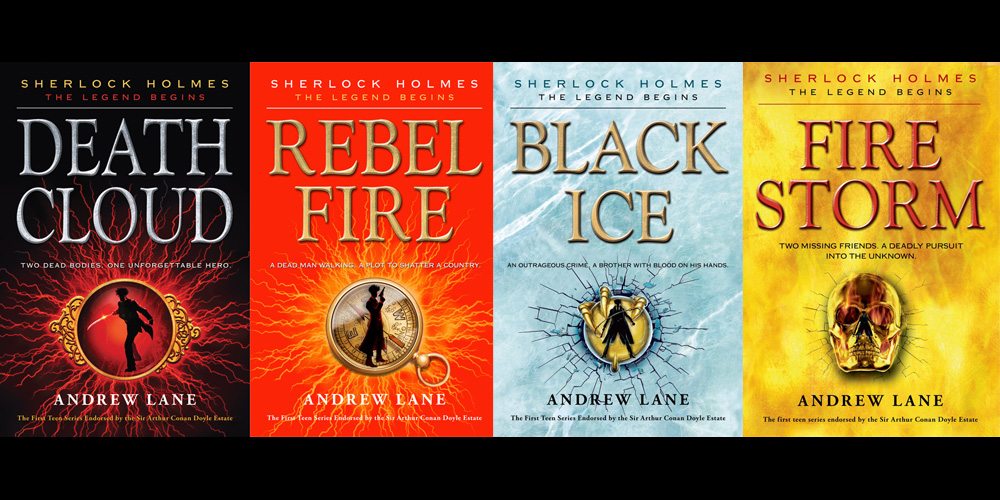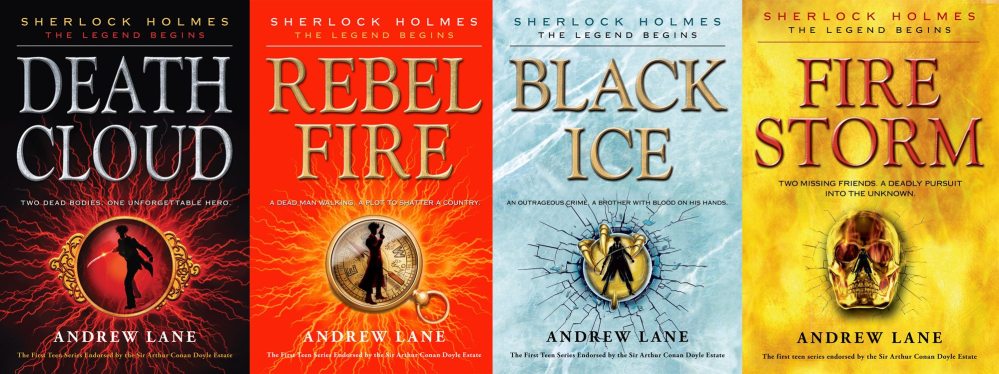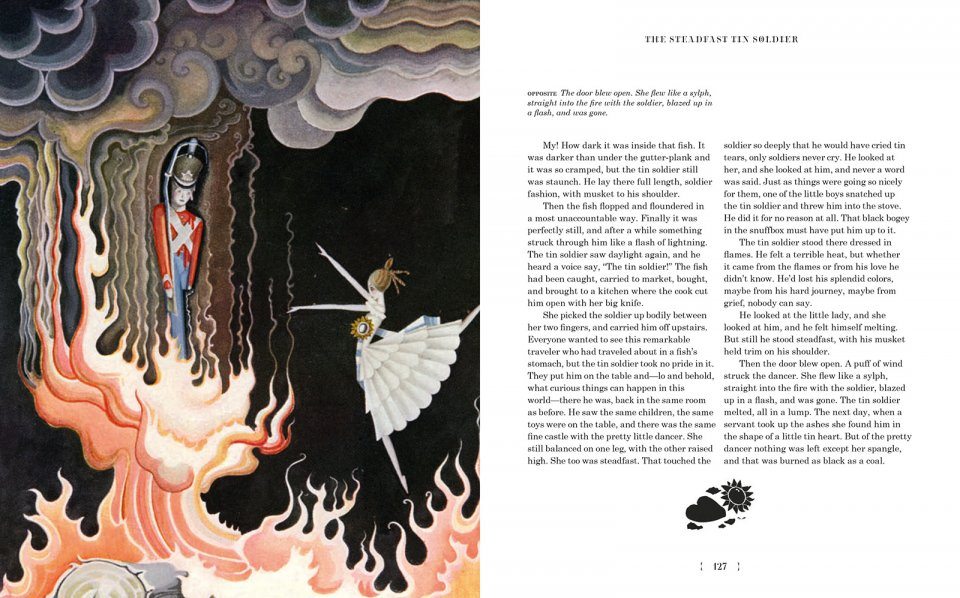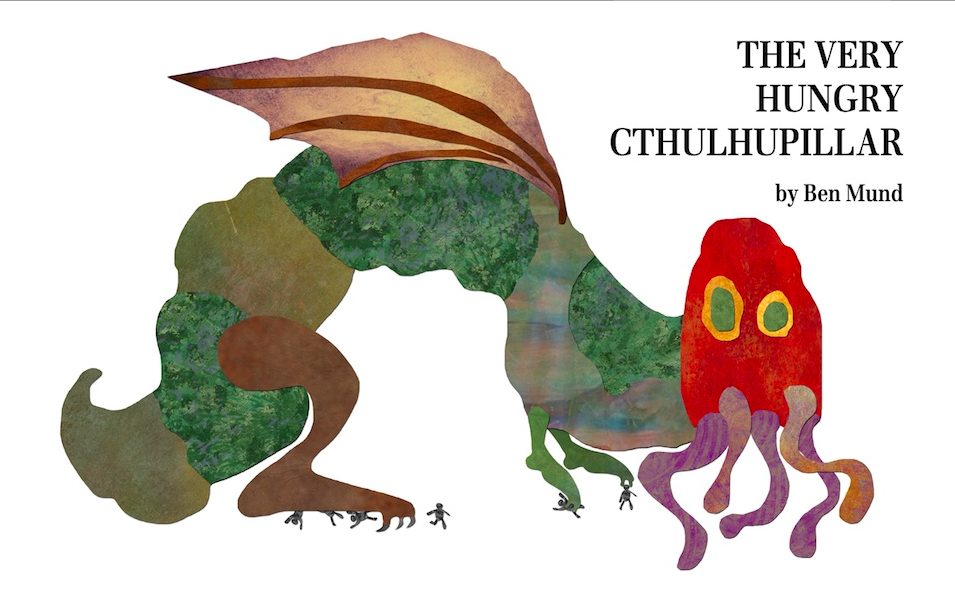Sherlock Holmes: The Legend Begins is an ongoing young adult series that explores Sherlock’s past. Somehow I missed it when it first started, but I’ve been catching up over the past two weeks. Fire Storm, the fourth volume, was released in the US last month (in the UK, they’re up to book six already). But first let me go back and fill you in a little in case you’re also new to the series.
The author, Andrew Lane, has written spin-off novels based on Doctor Who, and has been a fan of the great detective since he discovered him at age ten. This is actually the first young adult series endorsed by the Sir Arthur Conan Doyle Estate. (It’s interesting to note that Sherlock has passed into public domain in the UK, but in the US he’s still copyrighted until 2020, so he needed the estate’s permission to publish in the States.)
Lane takes us back to Sherlock at age 14. He weaves in real historical events with Sherlock’s fictional adventures, showing how he became the man we know from the original stories. How did he learn his incredible deductive skills? Where did he pick up the violin? How did he learn boxing, martial arts, and all of those other things? Throughout the series, we get bits and pieces of how Sherlock became interested in this or that.
The story is told in third-person view rather than being narrated by any of the characters, and it’s done in Lane’s own style rather than trying to imitate Conan Doyle. Although it can sometimes seem out of place reading about events from the 1860s in a contemporary style, I’ve read enough poorly-done imitations that I appreciate this approach. Plus, the books are intended for young adults so they needed to be easily accessible.
The first book, Death Cloud, finds Sherlock solving his first murder mystery. Sherlock has just been sent to Farnham to live with his estranged uncle and aunt, and is expecting to spend a very boring summer. But then two bodies turn up with similar appearances—boils on the body, and a mysterious cloud seen departing shortly after their deaths. With the help of his tutor Amyus Crowe (who has a mysterious background), Sherlock investigates the murders and uncovers something significantly larger.
Rebel Fire takes Sherlock to America—it turns out that John Wilkes Booth is apparently alive, and is somehow involved in a plot to revive the Confederacy. Black Ice starts with a murder mystery in which Sherlock’s brother Mycroft is found holding a knife in a room with a dead body—but clearing Mycroft’s name is just the first step. Sherlock eventually winds up in Russia, still piecing together exactly who the enemy is and what they are plotting. Finally, in Fire Storm, Amyus Crowe and his daughter have vanished—Sherlock tracks them to Scotland and discovers the one thing that Crowe is afraid of.
If you’re a fan of Sherlock Holmes, this is a fun way to explore his character. In these books, Sherlock has a lot of raw talent, but there is also a lot that he just hasn’t learned about yet. Crowe is hired as his tutor, but quickly becomes more than that—he’s a mentor and demonstrates many of the astute observational skills that Sherlock becomes known for. Matty Arnatt is a street urchin whom Sherlock befriends, and is sort of like a young Watson—always present and ready for adventure but with a very different set of skills. Virginia Crowe, Amyus’ daughter, is a tomboy and becomes Sherlock’s love interest, though it takes him a few books to understand his emotions toward her. And, of course, Sherlock’s brother Mycroft, who even at this point is already a prominent figure in the British government. I do have to wonder where these relationships are headed, given that none of these characters (aside from Mycroft) exist in Conan Doyle’s stories but they clearly have a huge influence on Sherlock in this series.
Lane isn’t trying to replicate Conan Doyle—young Sherlock is definitely a distinct character, even when you can see hints of who he will eventually become. These books tend to have more action scenes, and Sherlock and Matty get themselves into one deadly predicament after another. I do think it’s a bit funny, though: here Sherlock is battling an international conspiracy that seeks to overthrow entire governments and establish a new world order; as an adult, his cases include things like affairs and burglary and murder attempts. It almost seems like a step down from his childhood feats.
The writing isn’t perfect. There are a few similes that Lane overuses: shafts of sunlight appear to be beams holding up a ceiling in at least three cases, and I lost track of how many times Sherlock thought something seemed like hours but was only a matter of minutes. And, as I mentioned yesterday, there’s the problem that you never really fear that Sherlock is in mortal peril because he’s going to survive to adulthood. Overall, though, I found that I didn’t mind the occasional clunky writing because I enjoyed following the plot of the books and seeing where the next mystery would lead. It’s also fun identifying the things that will become a part of the adult Sherlock—though in case you need help, Lane generally includes an author’s note that talks about the types of research he did for each book and how things play into Sherlock’s future.
If you’re a fan of Sherlock Holmes and you’re looking for a fun read, check out The Legend Begins series. I’m looking forward to the next book in the series, and am contemplating buying the British version so I don’t have to wait…
You can find out more about the series at YoungSherlock.com (note that the links to purchase books there are the British versions).
Disclosure: Farrar Straus Giroux provided review copies of the first four books in the series.






Hey, these look like interesting books (even for an adult to read). Getting the first one for $4 from Amazon now.